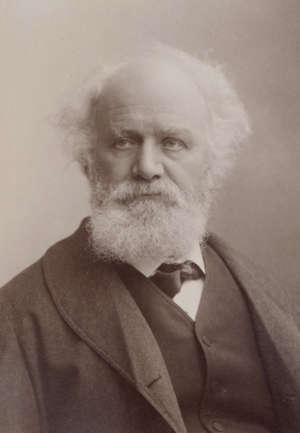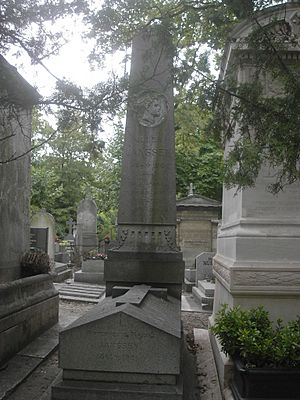Pierre Janssen facts for kids
Jules Janssen (born February 22, 1824 – died December 23, 1907) was a famous French astronomer. He is known for discovering that the Sun's outer layer, called the chromosphere, is made of gas. He also helped discover the element helium, which was first found in the Sun!
Contents
Janssen's Life and Adventures
Jules Janssen was born in Paris, France. His family was very cultured. His father, Antoine César Janssen, was a well-known clarinet player.
Janssen studied mathematics and physics at university. He taught at schools for a while. But most of his time was spent on exciting scientific trips.
Exploring the World for Science
In 1857, Janssen traveled to Peru. He went there to find the Earth's magnetic equator. This is an imaginary line where the Earth's magnetic field is perfectly flat.
He also went to Italy and Switzerland in the 1860s. There, he studied how Earth's air affects light from the Sun. This is called telluric absorption.
Janssen observed two rare events called transits of Venus. These are times when Venus passes directly in front of the Sun. He saw one in Japan in 1874 and another in Algeria in 1882.
He also joined many trips to see solar eclipses. These trips took him to places like Italy (1867), India (1868), and Spain (1905). During the Siege of Paris in 1870, he even escaped in a balloon to see an eclipse! Sadly, clouds blocked his view that time.
Inventing the Photographic Revolver
In 1874, Janssen invented something cool called the Revolver of Janssen. It was also known as the Photographic Revolver. This device could take many pictures very quickly. It was a very early form of chronophotography. This invention was later very helpful for other scientists. It helped them study movement and create early movies.
Discovering Helium in the Sun
In 1868, Janssen made a huge discovery about the Sun. He found a way to look at solar prominences without waiting for an eclipse. Solar prominences are huge, bright loops of gas that extend from the Sun's surface.
The Bright Yellow Line
While watching the solar eclipse of 18 August 1868 in India, he saw bright lines in the Sun's spectrum. This showed that the Sun's outer layer, the chromosphere, was made of gas.
One of these lines was a bright yellow color. It had a special wavelength of 587.49 nanometers. This was the first time anyone had seen this specific line. It meant there might be a new element in the Sun that hadn't been found on Earth yet.
Janssen realized he could see this spectrum even without an eclipse. So, he started observing it regularly.
Helium: An Element from the Sun
Around the same time, Joseph Norman Lockyer in England also saw the same yellow line. He used a powerful spectroscope.
Lockyer and a chemist named Edward Frankland worked together. They figured out that this yellow line came from an unknown element. They named it after the Greek word for the Sun, helios. This is how helium was first discovered in space before it was found on Earth!
Building Observatories
Janssen was very dedicated to studying the Sun. He wanted to know if the Sun contained oxygen. To find out, he needed to get rid of the effect of Earth's air.
The Mont Blanc Observatory
Janssen had a bold idea: build an observatory on top of Mont Blanc. This is the highest mountain in the Alps. By being so high up, there would be much less air above the observatory. This would make his observations clearer.
The observatory was built in September 1893. Its foundations were set deep into the ice on the mountain top. Even at 69 years old, Janssen climbed the mountain himself. He spent four days there taking important measurements.
Meudon Observatory and Solar Photos
In 1875, Janssen became the director of a new observatory. It was an astrophysical observatory built by the French government in Meudon.
Starting in 1876, he began taking amazing photos of the Sun. These were collected in his huge book, Atlas de photographies solaires (1904). He also published the first volume of the Annales de l'observatoire de Meudon in 1896.
Janssen was also the President of the French Astronomical Society from 1895 to 1897.
Honors and Legacy
Jules Janssen passed away in Meudon on December 23, 1907. He was buried in Paris.
During his life, he received many honors. He was made a Knight of the Legion of Honor. He also became a Foreign Member of the Royal Society of London.
To honor him, two craters are named after him. One is on Mars (Janssen (Martian crater)) and the other is on the Moon (Janssen (lunar crater)). A public square in front of the Meudon Observatory is also named Place Jules Janssen.
Two major awards also carry his name: the Prix Jules Janssen from the French Astronomical Society and the Janssen Medal from the French Academy of Sciences.
Janssen even named a small planet, 225 Henrietta, after his wife, Henrietta.
See also
 In Spanish: Pierre Janssen para niños
In Spanish: Pierre Janssen para niños




